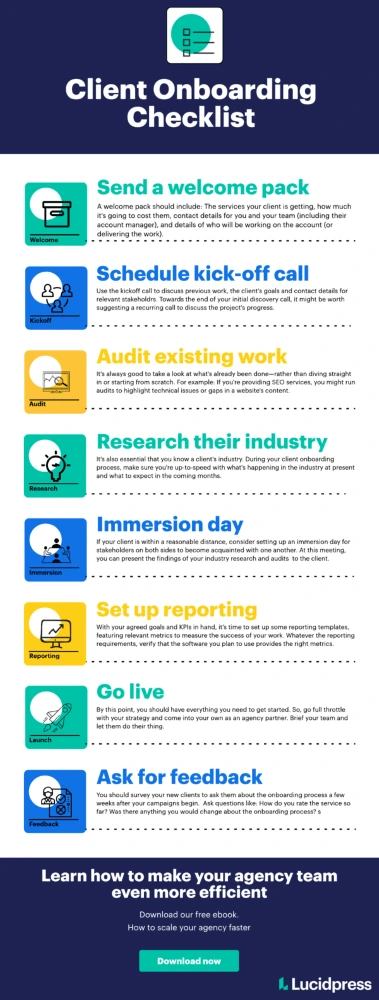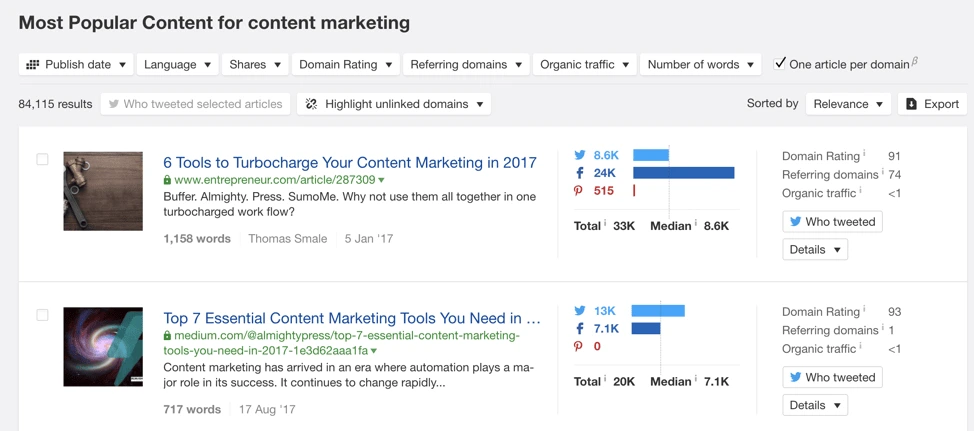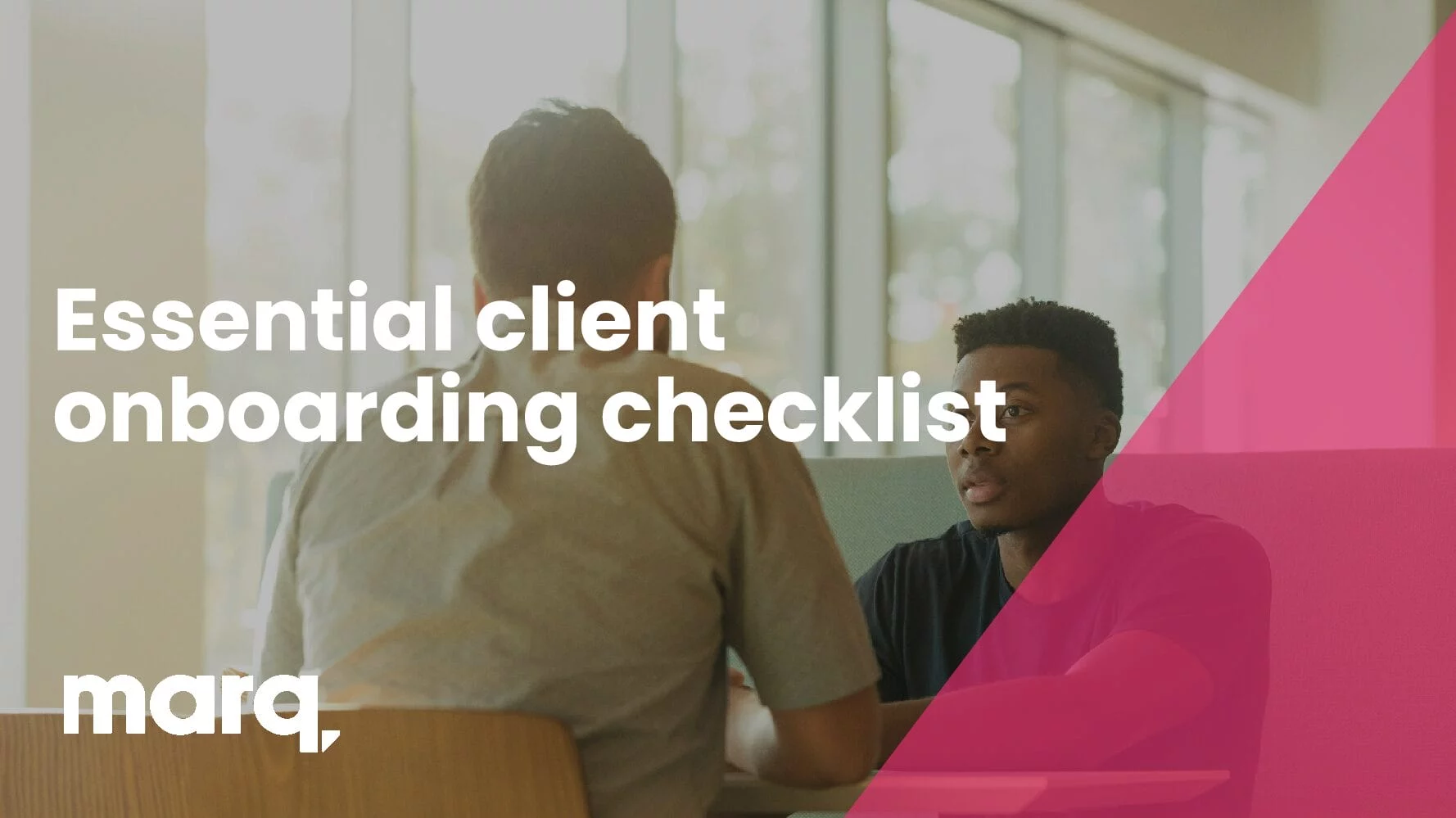You’ve answered a request for proposal (RFP), attended a couple of pitches, and now you’ve landed that new client you worked so hard to convert. Congratulations! …Now what?
For any agency (and client), a new relationship can be a daunting prospect—especially when you’re in the early stages. But with a solid client onboarding process in place to kick-off your first campaign, you can easily bring them up-to-speed with your typical engagement.
Related: How to write a creative brief (with examples)
So, what exactly should your onboarding process look like?
In this post, we’ll show you a simple 8-step client onboarding checklist to help you kick things off on a positive note—and make sure every new campaign starts on the right foot.
Let’s dive in.
What is client onboarding, anyway?
Client onboarding is the process of welcoming a new client onboard to your agency.
Whether you’re selling a service like graphic design or marketing, or a product like a software subscription, onboarding is essential for ensuring the relationship runs smoothly from the beginning.
Think about it: You’re unlikely to be impressed with an agency if they don’t have a streamlined way to get your first campaign rolling, right?
Your clients feel the same way. They want an easy, stress-free way to start working together—not one that takes six weeks of back-and-forth before your agency begins delivering the work they’re paying for.
A solid onboarding process is an important part of your client retention strategy, too.
Selling other services and making additional revenue from existing clients is much easier than attracting new clients. In fact, according to Lobster Marketing, there can be an up-to-70% chance of selling to an existing customer, compared with as little as 5% for a new prospect.

Source: Lobster Marketing
Get your client onboarding process right, and you’ll improve the chances of having a long-term relationship with them.
However, get it wrong and you run the risk of losing the client before you have the chance to impress them with your work—leading to higher churn, and of course, lost potential revenue.
A successful client onboarding checklist

Now, you understand the importance of offering a great service to retain your clients, and you know that it starts from the very first day of working with a new customer. But how do you ensure the onboarding process goes smoothly?
Here are eight things you’ll need to do when bringing a new client onboard.
1. Send a welcome pack and questionnaire
Your client onboarding process starts as soon as they’ve signed your contract. So, send out a welcome pack and questionnaire to bring them fully up-to-speed with your way of working, and answer any questions they might have before your agency starts delivering the work.
A welcome pack should include:
- The services your client is getting
- How much it’s going to cost them
- Contact details for you and your team (including their account manager)
- Details of who will be working on the account (or delivering the work)
You might also wish to include some timescales and turnaround times for the services provided. This helps to set boundaries and confirms expectations between the two parties.
Send a questionnaire at the same time, which asks key questions that are relevant to the work you’ll be delivering. Some of the things you might need to know include:
- Their target audience, customer or demographic
- Their budgets for the year
- Who they consider to be their main competitors
- Any upcoming development roadmaps or business campaigns
The questionnaire responses can help you tailor your offering to meet the client’s needs—and make sure you’re focusing on things they’re expecting results from.
2. Schedule a discovery kick-off call
A kickoff call is a great way to get some one-on-one time with your new client.
Whether you’re picking up the phone or planning a Zoom meeting, use your discovery call to go through the client’s questionnaire responses and learn more about why they’ve chosen to use your services.
The kickoff call can also be a great opportunity to discuss:
- Previous work, and any issues that occurred. (This might include asking what a previous agency did and whether there was anything the client didn’t like, so you can avoid similar roadblocks.)
- Your client’s goals and any KPIs you’ll use to report on your activity.
- Access to your client’s website, content management system, and Google Analytics or Ads accounts to prevent permissions from slowing down your first campaign.
- Contact details for relevant stakeholders on the client side, so you can get in touch with the right person at the right time.
Towards the end of your initial discovery call, it might be worth suggesting a recurring call—perhaps on a weekly or fortnightly basis—to discuss the project’s progress.
This is especially important in the onboarding stage, as you and the client get to know each other better. You want to prove you’re reputable, trustworthy and doing a good job, right?
3. Audit their existing activity
We know the feeling of being so excited to work with a new client that you’re itching to get started. But whether you’re delivering marketing or design services, it’s always good to take a look at what’s already been done—rather than diving straight in or starting from scratch.
You can get some great ideas on how to boost results, and identify potential strengths or weaknesses, just by doing just a little digging.
For example: If you’re providing SEO services, you might run audits to highlight technical issues or gaps in a website’s content.
If you’re delivering a social media campaign, however, browse their Twitter profile to see whether they’ve already got the foundations of a strong presence and just need a little tweaking to see an influx of results.
It’s a fantastic way to tailor your strategy to each client and search for low-hanging fruit that could deliver short-term results.
4. Research their industry
Sure, it helps to understand the products or services your client sells. But, it’s also essential that you know a client’s industry.
During your client onboarding process, make sure you’re up-to-speed with what’s happening in the industry at present and what to expect in the coming months.
Not only can this help you predict and plan around potential issues, you’ll also know what you’re competing with—and the tactics you’ll need to use to make their company stand out.
You can research a client’s industry by:
- Using social listening tools (such as Mention) to understand trending topics.
- Searching the topic in Buzzsumo and identifying industry influencers who may be helpful as part of a marketing campaign.
- Investigating what their competitors are doing with their SEO, content marketing and PPC activity using Ahrefs.

Source: Ahrefs
Prove to them you’re committed and eager to learn more about their industry—particularly if you haven’t worked with similar clients before.
5. Hold an immersion day
Granted, online calls are good if your client is on the other side of the world—but nothing can beat face-to-face meetings for getting to know people.
If your client is within a reasonable distance, consider setting up an immersion day for stakeholders on both sides to become acquainted with one another.
Take members of your team who will be working on the account. This will help them to get a feel for your client and their business—and more importantly, the boundaries your proposed strategy needs to fall within.
At this meeting, you can present the findings of your industry research and audits, as well as discuss next steps with the client. You could even take along some examples of your agency’s previous work or campaigns to show the client—especially if you’re unsure whether they’ll agree to out-of-the-box marketing ideas.
The immersion day is also a fantastic opportunity to get hold of essential documents you might need to deliver your work. This could include brand documentation such as:
- Buyer personas
- Brand guidelines
- House copywriting style guides
- Tone-of-voice documents
Remember: You’re trying to make a good impression. Don’t be afraid to go the extra mile if you’re hosting. Make it comfortable for your new client and reaffirm in their mind that they’ve chosen the best agency.
6. Set up reporting templates & tools
Following your discovery call and immersion meeting, you should now have a good idea of what your client wants to achieve.
With your agreed goals and KPIs in hand, it’s time to set up some reporting templates, featuring relevant metrics to measure the success of your work.
Let’s say you’re providing paid media services, for example. If your client’s goal is to reduce media spend and boost revenue, you’ll want to look at metrics like cost-per-click, revenue and ROI, and find a software that can report on all three.
For an SEO client, on the other hand, you’ll likely be monitoring keyword rankings and organic search traffic—which requires totally different software.
Whatever the reporting requirements, verify that the software you plan to use provides the right metrics, and that your in-house templates (where you’ll provide data from the software) are suitable for the client and tailored to their needs.
7. Go live!
Now that the majority of your client onboarding checklist has been checked off, let’s move on to the exciting part: launching your first campaign.
By this point, you should have everything you need to get started. So, go full throttle with your strategy and come into your own as an agency partner. Brief your team and let them do their thing.
During these first few weeks, make a conscious effort to double-check any deliverables to ensure they’re on point. Regular follow-up calls are a great way to keep everything on track and make sure everyone is on the same page.
Communication is key. You want to make a good impression early on, so it’s essential that you get it right—and that you’re open to feedback if the client has any suggestions.
8. Ask for feedback
After the initial onboarding stage has passed and you’re delivering work for the client, it can be tempting to focus only on the future. But, it’s important to take stock for a moment.
You should survey your new clients to ask them about the onboarding process a few weeks after your campaigns begin. It doesn’t have to be a long survey—remember, your client is probably ultra-busy.
But, you can ask some key questions to identify your strengths and areas for improvement, such as:
- How do you rate the service so far?
- Was there anything you would change about the onboarding process?
- Would you recommend our services or products?
Sending out a simple survey is a great opportunity for you to get feedback on your practices and adapt your onboarding plan for future clients to make it even more seamless next time.
Add a reminder to your client onboarding to-do list to make sure you don’t forget to ask for feedback. It’s likely that your current clients can suggest improvements to your onboarding process, which could help you convert new leads. Don’t shrug it off.
Key takeaway
Winning a new client is an exciting thing—and it should always be celebrated. But, you don’t want all the hard work that went into getting them onboard to be wasted.
A streamlined and sensible approach to onboarding new clients will help you deliver a great service, and it delight your customers at a crucial stage of your working relationship. Put these guidelines into practice to see the difference it makes first-hand.



